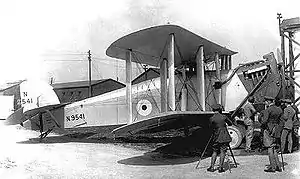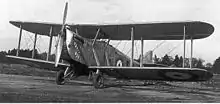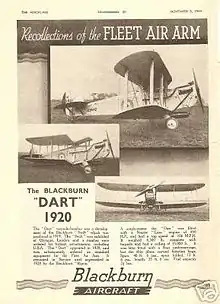Blackburn Dart
The Blackburn Dart was a British carrier-based torpedo bomber biplane, manufactured by Blackburn Aircraft, which first flew in 1921. The Dart was the standard single-seat torpedo bomber used by the Fleet Air Arm from 1923 until 1933. A modified variant was also sold to Greece, where they served with the Greek Navy.
| T.2 Dart | |
|---|---|
 | |
| Blackburn Dart T.2, N9541, 461 Flight, HMS Furious, c. 1930 | |
| Role | Torpedo bomber |
| Manufacturer | Blackburn Aircraft |
| First flight | October 1921 |
| Introduction | 1922 |
| Retired | 1933 |
| Primary user | Royal Air Force (Fleet Air Arm) |
| Produced | 1922–1928 |
| Number built | 118 (plus eight Swift export models) |
| Variants | Blackburn Velos |
Design and development

In 1919, Blackburn commenced the design of a private venture, carrier-based torpedo-bomber to replace the Sopwith Cuckoos which were the existing torpedo bombers flying from the Royal Navy's carriers. The Blackburn aircraft, the product of their chief designer, Major Frank Arnold Bumpus, was named T.1 Swift.[1] Although mainly conventional, the large biplane featured two-bay, equal-span wings that were staggered and could fold for storage aboard ship. The wing centre section structure was steel with wooden outer sections, all fabric covered.[2] Ailerons were mounted on all four wings. The fuselage was mounted on the lower wing, and also consisted of a metal structure with fabric covering. The tail unit had a braced tailplane and fin with a balanced rudder. The divided landing gear had mainwheels on oleo legs that allowed the fitting of a standard torpedo below the fuselage.[3][4]
The prototype Swift first flew in September 1920, almost crashing owing to a miscalculated centre of gravity.[5] This was resolved by sweeping back the wings, while a revised rudder was fitted to improve directional control. Following this, the Swift proved satisfactory, and an order was placed against Specification 3/20 for a further three aircraft for service trials. These were renamed the Blackburn Dart.[6]
The Dart was powered by either a Napier Lion IIB or V engine that was mounted with a thrustline angled upward; the fuselage also dropped sharply downwards from the cockpit.
The prototype Dart was first flown in October 1921, and despite its size handled well, exhibiting a remarkable 43 mph (69 km/h) stalling speed.

An export model of the Dart retained the name Swift and used the 450 hp (340 kW) Napier Lion engine. Seven were built as the Swift Mk II, two for the Japanese Navy, three for the Spanish Navy, and two for the United States Navy. The U.S. Navy aircraft were designated Swift F by Blackburn and Blackburn BST-1 by the U.S. Navy but following competitive trials in 1921, the U.S. Navy decided not to proceed with an order and purchased the Douglas DT-2 instead.
Operational history
The Dart T.2 entered service with the Fleet Air Arm in 1923 with No 460 Flight aboard HMS Eagle stationed in the Mediterranean and with 461 and 462 Flights on HMS Furious based in home waters. Shore training was conducted by "D3" Flight at Gosport. In 1928, the Blackburn Dart flew with Nos. 463 and 464 Flights embarked on HMS Courageous in the Mediterranean fleet. The following year, a single Dart was delivered to No. 36 Squadron RAF (Coastal Defence Torpedo Flight), initially for smokescreen trials and later to form part of the complement of torpedo bombers in the first fully operational Royal Air Force torpedo bomber squadron.
Three Darts were converted into two-seat seaplanes to provide advanced training from 1925 to 1929, at Blackburn's RAF Reserve School on the River Humber. The conversions led to a new variant, the T.3 Velos, which was ordered as a torpedo bomber by the Greek Navy in 1925.

The Dart continued in service with the Blackburn Reserve School, alongside a number of T.3s converted to landplanes until their eventual replacement by Ripons and Baffins in 1933.
One notable event marked the career of the Dart; Air Commodore G.H. Boyce became the first pilot to carry out a night deck landing, when he landed his Dart aboard Furious on 6 May 1926. The flight deck was illuminated by floodlights for the attempt but the docile Dart easily handled the task.
Variants
- T.1 Swift
- Prototype torpedo bomber, one built.
- Dart
- Prototype; one built.
- T.2 Dart
- Initial production variant – 117 built (three converted to two-seat trainers).
- Swift Mk II
- Export version – seven built.
- Swift F
- US Navy designation of the Swift Mk II for evaluation (would have been designated the BST-1 if ordered).
- T.3 Velos
- Two-seat variant for the Greek Navy – 16 built (12 under licence in Greece).
- T.3A Velos
- Company demonstrator and trial aircraft – six built.
Operators
- Japanese Navy (as Swift Mk II)
- Spanish Navy (as Swift Mk II)
- North Sea Aerial & General Transport Company (as T.3A Velos)
- Royal Air Force (Fleet Air Arm)
- United States Navy (as Swift F)
Specifications (Dart T.2)
Data from Jane's Encyclopedia of Aviation.[7]
General characteristics
- Crew: 1
- Length: 35 ft 4 1⁄2 in (10.782 m)
- Wingspan: 45 ft 5 3⁄4 in (13.862 m)
- Height: 12 ft 11 in (3.94 m)
- Wing area: 654 sq ft (60.8 m2)
- Empty weight: 3,599 lb (1,632 kg)
- Gross weight: 6,383 lb (2,895 kg)
- Powerplant: 1 × Napier Lion IIB W-12 water-cooled piston engine, 450 hp (340 kW)
- or 465 hp (347 kW) Lion V
- Propellers: 2-bladed fixed-pitch propeller
Performance
- Maximum speed: 107 mph (172 km/h, 93 kn) with dummy torpedo at 3,000 ft (914 m)
- Cruise speed: 100 mph (160 km/h, 87 kn)
- Stall speed: 43.5 mph (70.0 km/h, 37.8 kn)
- Range: 410 mi (660 km, 360 nmi)
- Service ceiling: 12,700 ft (3,900 m)
- Rate of climb: 600 ft/min (3.0 m/s)
Armament
- Guns: 1 × fixed, forward firing Vickers machine gun (not Mk II) and 1 × Lewis gun in rear cockpit.
- Bombs: 1 × Mark VIII or IX, 18 in (457 mm) torpedo or up to 2 × 520 lb (236 kg) bombs under each wing.
References
Notes
- Woodman 1996, pp. 2–3.
- Jackson 1968, pp. 139–140.
- Flight 7 May 1925, pp. 269–272.
- Woodman 1996, pp. 3–4.
- Mason 1994, p.130.
- Woodman 1996, p. 5.
- Taylor 1980, p. 306.
Bibliography
- "The Blackburn Twin-Float Seaplane." Flight, 7 May 1925, pp. 269–272.
- Jackson, A.J. Blackburn Aircraft since 1909. London: Putnam, 1968. ISBN 0-370-00053-6.
- Mason, Francis K. The British Bomber since 1914. London: Putnam, 1994. ISBN 0-85177-861-5.
- Sturtivant, Ray. "Fleet Air Arm Colours 1923–33." Scale Aircraft Modelling, Vol. 4, No. 6, March 1982.
- Taylor, Michael, J.H., ed. Jane's Encyclopedia of Aviation. Danbury, Connecticut: Grolier Educational Corporation, 1980. ISBN 0-7106-0710-5.
- Woodman, Harry. "Blackburn Dart:The Fleet Air Arm's Seminal Torpedo Bomber". Air Enthusiast, No. 63, May–June 1996. pp. 2–11.
External links
| Wikimedia Commons has media related to Blackburn Dart. |